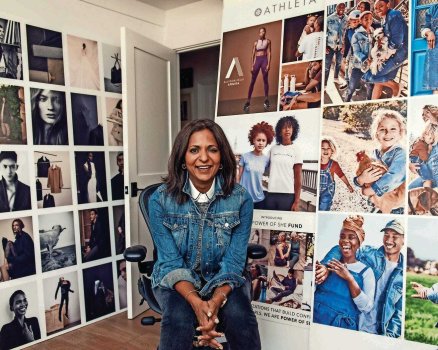K
Kathleen Martin
Guest
Giving women with a mix of backgrounds and experiences a seat at the corporate table makes good business sense all around. A 2020 McKinsey & Co. study showed that companies in the top quartile for gender and ethnic diversity were 25 percent more likely to have above-average profitability compared with those in the bottom quartile.
These corporate trailblazers have boldly pushed for inclusion, and taken chances in their careers — switching industries, helming startups and encouraging their businesses to embrace new markets — to create opportunities for themselves, their companies and future leaders:
Bridging the Gap
It’s difficult to find a company that’s pledged to double the representation of Black and Latino workers at all levels by 2025, or to increase the representation of Black employees in store leadership roles by 2025, but Gap Inc. has done both.
“We take this issue very seriously,” says Sonia Syngal, the company’s CEO. “We were also the first Fortune 500 company to announce equal pay for men and women.”
Out of more than 7,000 companies across the world, Gap was named one of the top five most diverse companies by the Thomson Reuters Global Diversity and Inclusion Index for two consecutive years. “Our north star is that we are inclusive by design,” says Syngal, who is now considered the highest-ranked Indian American female CEO of a Fortune 500 company since Indra Nooyi stepped down from her post at PepsiCo in 2018.
Even when she was at the helm of sister brand Old Navy, where she led the company to record-breaking growth between 2016 and 2020, Syngal relied on the same principles to guide her, often referring to the company’s goal of offering “affordable fashion to anyone regardless of gender, income and body shape.”

Last year, Gap became the first retailer to require all suppliers to pay garment workers electronically, which Syngal says is “a critical path to financial freedom.” She’s also the head of one of the only retailers to claim a workforce that is 55 percent Black, Latino, Asian American or something other than white.
This year, Gap announced it was regularly hosting diversity and inclusion workshops and includes mandatory racial equity training in its employee onboarding. “We started out as an inclusive company,” Syngal says. “Creating opportunities for the people and communities connected to our business inspires us to this day.”
Making a Difference
Rosalind Brewer may have grown up the daughter of assembly-line workers, but she is no stranger to the C-suite. In fact, she’s helped lead retail giants twice before her current position as CEO of Walgreens Boots Alliance, the company that owns Walgreens drugstores, having served as chief operating officer at Starbucks and president and CEO at Sam’s Club.
But her current position comes with one giant distinction: It makes Brewer the only Black woman at the helm of an S&P 500 company. “I take my role as one of the very few Black female CEOs very seriously,” Brewer says. “However, I look forward to the day when I’m no longer the first.”
Continue reading: https://www.usatoday.com/story/life/2021/12/05/female-leadership-power-brokers/8739192002/
These corporate trailblazers have boldly pushed for inclusion, and taken chances in their careers — switching industries, helming startups and encouraging their businesses to embrace new markets — to create opportunities for themselves, their companies and future leaders:
Bridging the Gap
It’s difficult to find a company that’s pledged to double the representation of Black and Latino workers at all levels by 2025, or to increase the representation of Black employees in store leadership roles by 2025, but Gap Inc. has done both.
“We take this issue very seriously,” says Sonia Syngal, the company’s CEO. “We were also the first Fortune 500 company to announce equal pay for men and women.”
Out of more than 7,000 companies across the world, Gap was named one of the top five most diverse companies by the Thomson Reuters Global Diversity and Inclusion Index for two consecutive years. “Our north star is that we are inclusive by design,” says Syngal, who is now considered the highest-ranked Indian American female CEO of a Fortune 500 company since Indra Nooyi stepped down from her post at PepsiCo in 2018.
Even when she was at the helm of sister brand Old Navy, where she led the company to record-breaking growth between 2016 and 2020, Syngal relied on the same principles to guide her, often referring to the company’s goal of offering “affordable fashion to anyone regardless of gender, income and body shape.”

Last year, Gap became the first retailer to require all suppliers to pay garment workers electronically, which Syngal says is “a critical path to financial freedom.” She’s also the head of one of the only retailers to claim a workforce that is 55 percent Black, Latino, Asian American or something other than white.
This year, Gap announced it was regularly hosting diversity and inclusion workshops and includes mandatory racial equity training in its employee onboarding. “We started out as an inclusive company,” Syngal says. “Creating opportunities for the people and communities connected to our business inspires us to this day.”
Making a Difference
Rosalind Brewer may have grown up the daughter of assembly-line workers, but she is no stranger to the C-suite. In fact, she’s helped lead retail giants twice before her current position as CEO of Walgreens Boots Alliance, the company that owns Walgreens drugstores, having served as chief operating officer at Starbucks and president and CEO at Sam’s Club.
But her current position comes with one giant distinction: It makes Brewer the only Black woman at the helm of an S&P 500 company. “I take my role as one of the very few Black female CEOs very seriously,” Brewer says. “However, I look forward to the day when I’m no longer the first.”
Continue reading: https://www.usatoday.com/story/life/2021/12/05/female-leadership-power-brokers/8739192002/

